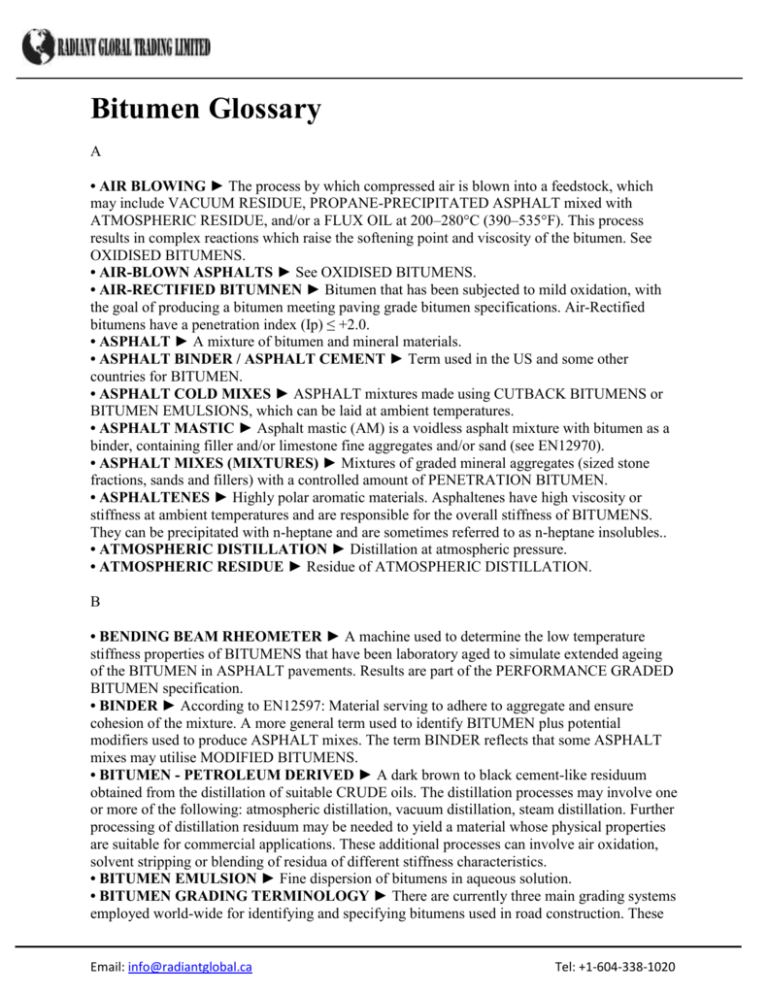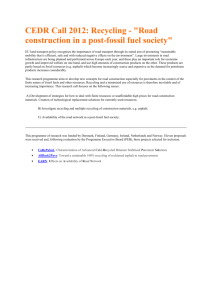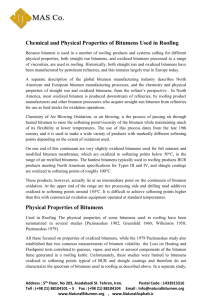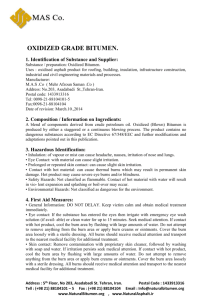Word - oxidized bitumen
advertisement

Bitumen Glossary A • AIR BLOWING ► The process by which compressed air is blown into a feedstock, which may include VACUUM RESIDUE, PROPANE-PRECIPITATED ASPHALT mixed with ATMOSPHERIC RESIDUE, and/or a FLUX OIL at 200–280°C (390–535°F). This process results in complex reactions which raise the softening point and viscosity of the bitumen. See OXIDISED BITUMENS. • AIR-BLOWN ASPHALTS ► See OXIDISED BITUMENS. • AIR-RECTIFIED BITUMNEN ► Bitumen that has been subjected to mild oxidation, with the goal of producing a bitumen meeting paving grade bitumen specifications. Air-Rectified bitumens have a penetration index (Ip) ≤ +2.0. • ASPHALT ► A mixture of bitumen and mineral materials. • ASPHALT BINDER / ASPHALT CEMENT ► Term used in the US and some other countries for BITUMEN. • ASPHALT COLD MIXES ► ASPHALT mixtures made using CUTBACK BITUMENS or BITUMEN EMULSIONS, which can be laid at ambient temperatures. • ASPHALT MASTIC ► Asphalt mastic (AM) is a voidless asphalt mixture with bitumen as a binder, containing filler and/or limestone fine aggregates and/or sand (see EN12970). • ASPHALT MIXES (MIXTURES) ► Mixtures of graded mineral aggregates (sized stone fractions, sands and fillers) with a controlled amount of PENETRATION BITUMEN. • ASPHALTENES ► Highly polar aromatic materials. Asphaltenes have high viscosity or stiffness at ambient temperatures and are responsible for the overall stiffness of BITUMENS. They can be precipitated with n-heptane and are sometimes referred to as n-heptane insolubles.. • ATMOSPHERIC DISTILLATION ► Distillation at atmospheric pressure. • ATMOSPHERIC RESIDUE ► Residue of ATMOSPHERIC DISTILLATION. B • BENDING BEAM RHEOMETER ► A machine used to determine the low temperature stiffness properties of BITUMENS that have been laboratory aged to simulate extended ageing of the BITUMEN in ASPHALT pavements. Results are part of the PERFORMANCE GRADED BITUMEN specification. • BINDER ► According to EN12597: Material serving to adhere to aggregate and ensure cohesion of the mixture. A more general term used to identify BITUMEN plus potential modifiers used to produce ASPHALT mixes. The term BINDER reflects that some ASPHALT mixes may utilise MODIFIED BITUMENS. • BITUMEN - PETROLEUM DERIVED ► A dark brown to black cement-like residuum obtained from the distillation of suitable CRUDE oils. The distillation processes may involve one or more of the following: atmospheric distillation, vacuum distillation, steam distillation. Further processing of distillation residuum may be needed to yield a material whose physical properties are suitable for commercial applications. These additional processes can involve air oxidation, solvent stripping or blending of residua of different stiffness characteristics. • BITUMEN EMULSION ► Fine dispersion of bitumens in aqueous solution. • BITUMEN GRADING TERMINOLOGY ► There are currently three main grading systems employed world-wide for identifying and specifying bitumens used in road construction. These Email: info@radiantglobal.ca Tel: +1-604-338-1020 systems are PENETRATION, VISCOSITY and PERFORMANCE GRADED. Although each system has test methods that are unique to that system, similar bitumens are used across all grading systems. The particular system used within a given country or region is generally a result of historical practices or governmental stipulations. • BITUMEN ENAMEL (BITUMEN PAINT) ► An external coating for protecting steel pipes. The term can also be used for bitumen paints (formulated CUTBACK BITUMENS or BITUMEN EMULSIONS). • BITUMEN MACADAM ► A type of ASPHALT mix with a high stone content and containing 3–5% by weight of bitumen. • BITUMEN PAINT ► A CUTBACK BITUMEN made to treat bare metal or concrete or wood surfaces, giving a bond between the surface and an ENAMEL or a bituminous membrane or bonding bitumen. • BITUMEN PRIMER ► A CUTBACK BITUMEN made to treat bare metal surfaces giving a bond between the metal and an ENAMEL. • BLENDED BITUMENS ► Blends of two or more bitumen substances with different physical characteristic in order to achieve desired physical properties. • BUILT UP ROOFING ASPHALT (BURA) ► OXIDISED BITUMEN used in the construction of low slope built up roofing (BUR) systems; specification defined by ASTM D312. This material is called Built-Up Roofing ASPHALT (BURA) in North America. C • CAS REGISTRY ► A large database of chemical substance information in the world containing more than 29 million organic and inorganic substances and 57 million sequences. • CAS REGISTRY NUMBER ► A CAS Registry Number is assigned to a substance when it enters the CAS REGISTRY database. • CATALYTIC AIR-BLOWN BITUMENS ► OXIDISED BITUMENS produced using catalysts in AIR BLOWING. • COAL TAR ► A product manufactured by the high-temperature carbonisation of bituminous coals which differs from bitumen substantially in composition and physical characteristics • COLLOID MILLS ► High-speed shearing devices in which hot bitumen can be dispersed in an aqueous solution to produce a BITUMEN EMULSION. • CRUDE OIL ► See CRUDE PETROLEUM. • CRUDE PETROLEUM ► A naturally-occurring mixture, consisting predominantly of hydrocarbons but also containing sulphur, nitrogen or oxygen derivatives of hydrocarbons, which can be removed from the earth in a liquid state. • CUTBACK BITUMENS (PETROLEUM) ►Bitumen whose viscosity has been reduced by the addition of a CUTBACK SOLVENT derived from petroleum. • CUTBACK SOLVENT (PETROLEUM) ► Relatively volatile fluid used in the manufacture of CUTBACK BITUMEN. Typically white spirit and kerosene are the petroleum derived solvents employed. D • DRUM-MIXER ► An ASPHALT mixing device, in which mixtures of MINERAL AGGREGATE and bitumen are heated and combined in a rotating drum. • DYNAMIC SHEAR RHEOMETER ► A testing device used to determine the stiffness of bitumens over a range of temperatures and test frequencies. Typically a standard amount of Email: info@radiantglobal.ca Tel: +1-604-338-1020 bitumen (25 mm in diameter by 1 mm in thickness) tested between two flat plates (25 mm in diameter). An oscillatory stress or strain of known value is applied to the bitumen sample and the resultant strain or stress is measured. From these data the stiffness of the bitumen is calculated. The stiffness results are part of the specification within the PERFORMANCE GRADED system of specifications. E • EINECS (European INventory of Existing Commercial chemical Substances) ► Analogous to the CAS system by which chemical substances were registered under the EU Existing Substances Regulation. F • FILLER ► Fine mineral matter (e.g. limestone dust, Portland cement or stone dust) employed to give body to a bituminous binder or to fill the voids of the sand. • FLEXIBLE PAVEMENTS ►Road surfacings made from layers of ASPHALT mixes. • FLUXED BITUMEN (Petroleum fluxed bitumen) ► A bitumen, whose viscosity has been reduced by the addition of a flux oil derived from petroleum. Note: Typically gas oils of various distillation ranges are employed as the flux oil. • FLUX ►This term has different meanings in different regions, e.g. North America: Also referred to as ROOFING FLUX. A term of art referring to a raw material from which oxidised bitumen is made. Typically soft bitumens [less than 50 Pa•s @ 60°C (140°F)] are used, although bitumens of higher viscosity can be included within the definition of FLUX. In Europe: FLUX refers to FLUX or FLUX OIL, a relatively involatile fluid (oil) used in the manufacture of fluxed bitumen. • FLUX OILS (PETROLEUM) ►This term has different meanings in different regions, e.g. North America: High flashpoint hydrocarbon oils (generally paraffinic) added to a ROOFING FLUX prior to oxidizing. The purpose of a FLUX OIL is to enable manufacture of oxidised bitumens with higher penetration values at a given softening point than would be possible without incorporation of the FLUX OIL. Europe: FLUX refers to FLUX or FLUX OIL, a relatively involatile fluid (oil) used in the manufacture of fluxed bitumen. It also refers to the diluent used in the manufacture of OXIDISED BITUMEN. G • GAS OIL ► A liquid petroleum distillate with a viscosity and boiling-range between those of KEROSENE and lubricating oil. H • HARD BITUMEN ► A bitumen possessing low penetration value and high softening-point. These are used in the manufacture of high modulus ASPHALT MIXTURES. K Email: info@radiantglobal.ca Tel: +1-604-338-1020 • KEROSENE (KEROSINE) ► A petroleum distillate consisting of hydrocarbons with carbon numbers predominantly in the range of C9 through C16 and boiling in the range of 150–290°C (300–550°F). L • LAKE ASPHALT ► Most common form of NATURAL ASPHALT, occurring in Trinidad. M • MASTIC ASPHALT ► Mastic asphalt (MA) is a dense mass mixture consisting of coarse aggregate, and/or sand, and/or limestone fine aggregate, and/or filler and bitumen, which may contain additives. The mineral aggregate is composed to be of low void content. %m: Percent by mass. The mass of material reflects the quantity of matter within a sample. %w: Percent by weight. Weight is defined as the mass multiplied by the force of gravity (Earth gravity is approximately 9.8m.s-1). • MINERAL AGGREGATE ► A combination of stone fractions and FILLER. • MODIFIED BITUMENS ► Bituminous binder whose rheological properties have been modified during manufacture by the use of one or more chemical agents. • MOPPER ► A worker who spreads hot bitumen on a roof with a mop. N • NATURAL ASPHALT ►Naturally-occurring mixture of bitumens and mineral matter formed by oil seepages in the earth’s crust. Natural asphalts include Trinidad Lake, Rock, Gilsonite, Selenica and others. O • OXIDISED BITUMEN ► Bitumen whose rheological properties have been substantially modified by reaction with air at elevated temperatures. Oxidised bitumens have a penetration index (Ip) > +2.0. These materials are also sometimes referred to as “blown bitumens” and, in the USA, AIR-BLOWN ASPHALT. There is significant use in Europe for oxidised bitumen to manufacture membranes and shingles, much of which is applied cold. In the USA, oxidised bitumen is also used in built-up roofing applications. P • PAH, PAC ► Polycyclic Aromatic Hydrocarbons is the collective name for a large group of several hundred chemicals that have a characteristic structure of two or more fused aromatic rings. They are a class of organic compounds and also a sub-group of the larger family of chemicals - Polycyclic Aromatic Compounds (PAC). • PAVER ► Machine fitted to receive ASPHALT mixtures and to spread them as a compacted layer or course of controlled width and height. • PERFORMANCE GRADED BITUMENS ► Bitumens classified based on the research results of the Strategic Highway Research Program (SHRP). Performance Graded (PG) specifications are based on the stiffness of the bitumen at the high and low temperature Email: info@radiantglobal.ca Tel: +1-604-338-1020 environment in which the bitumen will be expected to perform within pavement. Currently Performance Graded Bitumens are most widely utilised in the United States and Canada. • PENETRATION GRADED BITUMENS ► Bitumens classified by the depth to which a standard needle will penetrate the bitumen sample under specified test conditions. (See ASTM D5 for an explanation of the penetration test). • PENETRATION TEST ► Specification test to measure the hardness of bitumen under specified conditions. In which the indentation of a bitumen in tenths of a millimetre at 25°C (77°F) is measured using a standard needle with a loading of 100 g and 5s duration. Details of the test can be found in ASTM test method D5 as well as other sources. • PLASTOMER ► A polymer type which exhibits stiffness and strength but does not recover substantially when deformed. Examples of this type of polymer used in bitumens are ethylene vinyl acetate, ethylene methacrylate, polyethylene, and atactic polypropylene, • POLYMER MODIFIED BITUMEN/ASPHALT (PMB/A) ► MODIFIED BITUMEN, in which the modifier used is one or more organic polymers. • PROPANE-PRECIPITATED ASPHALT (PROPANE BITUMEN) ► See SOLVENT PRECIPITATION. • PUG-MILL ► Mixer used to combine stone materials and bitumen in an asphalt-mixing plant. The mixing is effected by high-speed stirring with paddle blades at elevated temperatures. R • RAFFINATE ► The part of a liquid, especially an oil, remaining after its more soluble components have been extracted by a solvent. • RAKERMAN ► Worker at the back of a finishing machine who adjusts minor imperfections in the levelled asphalt course, usually by means of a hand rake. • REFINERY ► Facility composed of a group of separation and chemical engineering unit processes used for refining crude oil into different oil products. • ROAD OILS ► Term sometimes used for very soft VACUUM RESIDUE or harder BITUMENS that have FLUX OIL added, or CUTBACKS that have been produced using petroleum with a boiling point greater than 225°C (435°F) added to reduce the viscosity. ROAD OILS are generally used to produce ASPHALT paving mixes for use on very low volume roads in moderate to cold climates. • ROCK ASPHALT ► Naturally-occurring form of ASPHALT, usually a combination of bitumen and limestone. Found in south-eastern France, Sicily and elsewhere • ROOFING ASPHALTS ► Bitumen used for manufacture of roofing systems or roofing products. These can be oxidised bitumens when producing bitumen shingles or BURA and straight run bitumens when producing Mod Bit membranes and roofing adhesives. • ROOFING FELT ► A sheet material, impregnated with bitumen generally supplied in rolls and used for waterproofing roofs. • ROOFING KETTLE ► A heated vessel used to raise the temperature of roofing bitumens to working level. They may be fitted with various types of heating devices and lids. • ROTARY DRUM DRYER ► A device in an asphalt-mixing plant used to dry and heat stone materials. S • SATURATES ► These comprise predominantly straight- and branched-chain aliphatic hydrocarbons together with alkyl naphthenes and alkyl aromatics. Their molecular weight is Email: info@radiantglobal.ca Tel: +1-604-338-1020 similar to that of CYCLICS. This fraction is derived using solvent precipitation and adsorption chromatography. • SCREED ► Levelling device at the rear of a finishing machine. Can also apply to boards or metal edges used to level MASTIC ASPHALT. • SKIP-HOIST ► A device for transfer of ASPHALT MIXES from a PUG-MILL to storage. • SOFTENING-POINT ► Specification test in which the temperature is measured in °C at which a bitumen (in the form of a disc under given loading conditions) softens and extends a fixed distance (see ASTM D 36 and EN 1427). • SOLVENT EXTRACTS ► Aromatic by-products (extracts) obtained from the refining of BASE OILS. • SOLVENT PRECIPITATION ► The process by which a hard product, PROPANEPRECIPITATED ASPHALT, is separated from a vacuum residue by solvent precipitation (usually with propane). PROPANE-PRECIPITATED ASPHALT is truly a bitumen by the definitions applied in this monograph. In the USA, this process is called ‘solvent deasphalting’ and the product, SOLVENT-REFINED ASPHALT. • SOLVENT-REFINED ASPHALT ► Term used in the USA for PROPANEPRECIPITATED ASPHALT. • STEAM-REFINED BITUMENS ► VACUUM RESIDUES that have been subjected to STEAM STRIPPING. • STEAM STRIPPING ► Injection of steam into a residue, which aids VACUUM DISTILLATION. • SMA ► Referred to as STONE MASTIC ASPHALT in Europe or STONE MATRIX ASPHALT in the United States. SMA is a gap-graded asphalt mixture that has higher proportion of coarse aggregate, lower proportion of middle-size aggregate, and higher proportion of mineral filler than a dense-graded mixture. Differs from MASTIC ASPHALT in the proportion of coarse aggregate used in the mix and is paved at temperatures typically employed for conventional ASPHALT mixtures. • STRAIGHT-REDUCED BITUMENS ► VACUUM RESIDUES used as bitumens. STEAM STRIPPING may have been used in their production. • STRAIGHT-RUN BITUMENS ► Similar to STRAIGHT-REDUCED BITUMENS and STEAM-REFINED BITUMENS. • SULPHUR EXTENDED ASPHALT ► A hot mixed asphalt in which part of the bituminous binder is replaced by elemental sulphur, typically at levels between 20–40%m of the original bitumen content. • SURFACE DRESSING ► Process used to seal road surfaces; a thin film of bitumen, CUTBACK BITUMEN or BITUMEN EMULSIONS is spread, covered with a single or double layer of chippings, and then rolled. • SURFACE TREATMENT ► May include SURFACE DRESSING and other techniques, such as spraying with minor amounts of BITUMEN EMULSION to bind surfaces together. T • TERMINAL ► A facility outside a refinery where bitumen is held for intermediate storage prior to delivery to (or collection by) customers. • THERMALLY CRACKED BITUMENS ► Also known as residues (petroleum), thermal cracked, vacuum: Bitumens produced by thermal cracking. Email: info@radiantglobal.ca Tel: +1-604-338-1020 • TOPPING PLANT ► A ‘stand alone’ distillation plant. Topping plants are usually found in terminals and used to remove distillate materials added to bitumens for transportation purposes. V • VACUUM DISTILLATION ► Distillation of ATMOSPHERIC RESIDUE under vacuum. • VACUUM RESIDUE ► Residue obtained by VACUUM DISTILLATION. • VISBREAKING ► A relatively mild thermal cracking operation mainly used to reduce the viscosity and pour point of vacuum residues for subsequent use in heavy fuel oils. The process converts a proportion of the residue feedstock to distillate product, e.g. gas oil. • VISCOSITY ► Resistance to flow. For bitumen products, test methods include vacuumcapillary, rotational and orifice-type viscometers. • VISCOSITY-GRADED BITUMENS ► Bitumens which are graded and specified by their viscosity at a standard temperature, which is typically 60°C (140°F) (typically, viscosity tests ASTM D2171 or EN 12596 are used). W • WARM MIX ASPHALT ► A type of hot mixed asphalt, which is produced at lower than normal temperatures. Typically warm mixed asphalts are produced at temperatures between 100130°C. Email: info@radiantglobal.ca Tel: +1-604-338-1020






